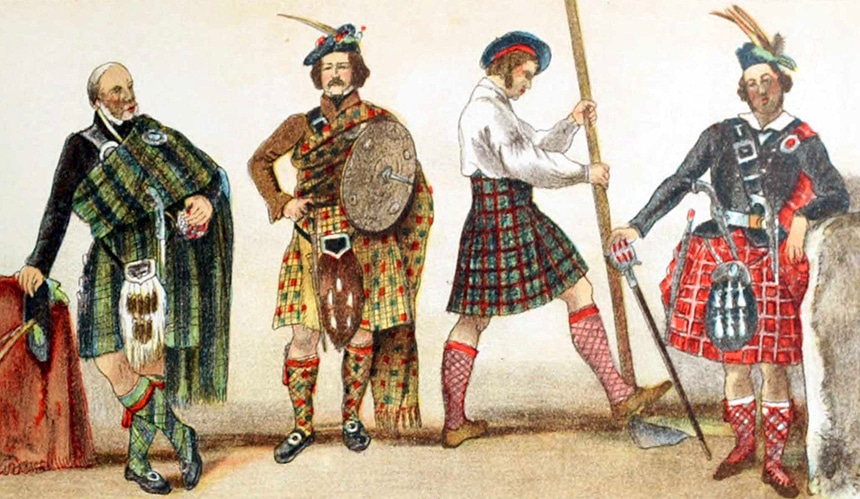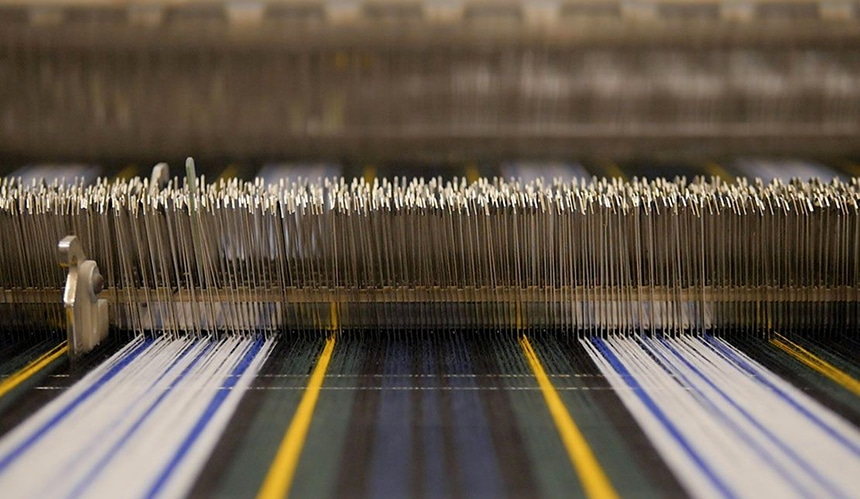

The tartan and plaid are clothing types that were popularized in Scotland. They are used in making the kilt, a traditional Scottish garment that is usually worn by men. Meanwhile, there are the woolen kilts designed to have the traditional Scottish motif. They have pleats around the back, are usually not longer than the knee, and the top halves are crapped across the shoulder to be worn like they were capes. These are what they call the plaid. This is probably why the terms seem similar and are sometimes used interchangeably. But in this tartan vs plaid comparison, we’ll try to shed more light on the origin of these fabrics and patterns and see where they differ.

The term tartan derives from an old French word, tiritaine, which means “rough and woolly” and indicates a particular type of dyed woolen fabric originally from Scotland. Precisely because it was born in the Scottish Highlands to distinguish individual families with traditional color combinations. The houses were of great importance because the Celtic peoples gathered around them building clans. The Scottish garment par excellence, the kilt, is made of tartan fabric: it is a kilt worn by men in the special uniforms required in some official ceremonies.
The traditional tartan also commonly called Scottish tile because of its shimmering colors with its predominance of red.
Its particularity is the “sett” lines, a series of symmetrical colored threads which are reversed on the pivots. Anyway, beware of the “grandpa” effect that tartan has.
The first evidence of tartan-like patterns was found in the Chinese Taklamakan desert, along the Silk Road. It was there that the Swedish researcher Sven Hedin discovered 3,000-year-old mummies Trusted Source Lost treasures of Middle China One of the most revealing aspects was in the very sophistication of their clothes. Their weaving techniques were analyzed in 1999 by a leading textile archaeologist, Elizabeth Wayland Barber, who has drawn surprising parallels with methods known by the Celts. Indeed, similar beautiful checked cloths (circa 1200-700BC) found with burials near Hami, Xinjiang (see map) bear astonishing resemblance to traditional modern Scottish ‘tartan’ checks. www.sundaytimes.lk . These mummies, apparently Celtic traders who traveled the Silk Road, wore complex woven wool tartans. Roman writers also tell of Celtic warriors who were dressed in woven and colorfully patterned fabric.
However, it was another 1,500 years before significant written evidence of the use of tartans was given. The first important reference is a German woodcut from 1631, which shows Scottish mercenaries of the Swedish king Gustav Adolph, who wore the “great kilt” with a recognizable check pattern (the tartan).
Nevertheless, the tartans were far from uniform at the time and were not seen as a symbol of a particular clan. The differences in design and color were purely for technical or geographical reasons: every clan or region and the highland valley had a weaver who wove the fabrics for all people.
This weaver wove the fabric patterns and checks according to his taste and traditional traditions and techniques that were taught to him by his predecessor, mostly his father. He also dyed the fabrics with plants that he found around him. So it’s not surprising that the patterns and colors differed depending on the craftsman and region. A weaver on the east coast had different plants for coloring the fabrics than one in the west. Even neighboring highland glens sometimes had different vegetation. The tartans did not initially differ from clan to clan but only from region to region. Only over time did they become identifying marks for certain clans. However, not every clan had its distinctive pattern.
At the Battle of Culloden in 1745, an attempt was made to use tartans as a uniform for the first time. This battle was both the climax and the end of the Jacobite Rebellion, in which the Scottish highlands rebelled against the English occupiers under the leadership of the romantic “Bonnie Prince Charlie” (Charles Edward Stuart, the aspirant to the Scottish throne). The Highlanders were slain by an outnumbered English army and the uprising was over.

As a result, there came an act for disarming the Highlands in Scotland, for more effectual securing of peace of the said Highlands, and for restraining the use of the Highlands dress. In addition, the wearing of the kilt and a tartan was banned. This ban lasted until 1782, during which time the traditional Scottish clan fabric, knowledge of traditional Scottish clothing, and the making of tartans in the Highlands were practically wiped out.
However, the ban only applied to common people from the highlands. Nobles, men from the Lowlands, and members of the Scottish regiments were still allowed to wear kilts and tartans. The army, in particular, had a great need for tartan material, as they recorded a large influx of recruits from the Highlands who wanted to escape the poor conditions as a result of the so-called “Highland Clearances”, the systematic expulsion of the Scots by Scottish and English landowners.
The weaver William Wilson recognized this increasing demand and established his weaving mill “William Wilson and Son of Bannockburn” in Bannockburn near Stirling in 1765, specializing in the weaving of tartan fabrics. Because the military wanted uniform fabrics, Wilson began standardizing the patterns and colors.
Some of these patterns were named after regions or cities, and others were simply numbered consecutively. The tartans were finally summarized in the so-called “Key Pattern Book” in 1819. These patterns are still used today as the basis of many tartans.
The tartan finally got its biggest boom from Queen Victoria and her Prince Consort Albert, who adored everything Scottish. The “noble” Highlander and everything from the Highlands were romanticized by British society and Prince Albert himself designed the now-famous “Balmoral tartan”. During this time of the romanticization of the Highlands, two brothers appeared who posed as illegitimate descendants of Bonnie Prince Charlie. They pretended to have found an old manuscript. On the alleged basis of this manuscript, which they could never produce, they published a large number of tartans and assigned them to the clans. There were slight variations of more well-known tartans, of many of the “traditional” tartans used today,
Wilsons of Bannockburn also recognized the market and designed more and more tartan patterns for the market, which they initially mostly only gave numbers, but later the names of the biggest buyers or simply the name of the region with the best sales. Large highland and even lowland families (which were previously completely “tartanless”) gradually began to make their tartan that would set them apart from the other families.
Nothing about the fascination of the tartan has changed these days. Millions of descendants of Scottish immigrants from the USA, Canada, Australia, and New Zealand are looking for their family history and discover the sign of the “old Celtic clan tradition”, the tartan, for themselves.

The tartan pattern (when not just printed) is a mix of yarns in different colors. Each thread of the chain (the length of the fabric) crosses each thread of the weft (the width of the fabric). If both threads are the same color, then the color will be solid. If the threads are different colors, then a third color will be created.
Mathematically, the more the number of colors at the start, the more the motive will be multicolored. The tartan being a symmetrical pattern, its manufacture is regulated by a sequence of colors of threads. There can sometimes be non-symmetrical tartans, but this is not the norm.
Say you want to have your tartan made, here’s how to describe the sequence of yarns and colors to be used by the weaver. Each color is symbolized by a letter (K for black, B for blue, T for tan, W for white, G for green, Y for yellow…).
The pattern has been around for at least 5,500 years. But it is the Celts who use it to differentiate the inhabitants of the different districts. The number of colors in the tartan depends on the rank of the person wearing it:
From the 19th century, the tartan motif became the emblem of a clan. In the end, the big families in the districts made the designs their own, so it was possible to tell who was who just by looking at the dress.
If this is a first for you, you can combine a tartan pattern on an accessory or detail (a scarf, a lining, a tie, etc.). If you’re up for it, dare the tartan on your pants, a casual jacket, and simplify the rest of your outfit.
You can also wear a tartan on leggings or tights. You can wear them with tights on gauntlets. In this case, the tight can be thinner and transparent.
Plaid is what is commonly called the tartan in the West, especially in America. Hence, this is why it is used interchangeably as tartan. The word plaid comes from the Gaelic language in Scotland. This means blanket originally. Plaid used to be the cloak or woolen scarf that is draped across the shoulder by Scottish highlanders.
The video below explains how to wear a plaid.
One of the most beautiful plaid fabrics is the Ambesonne Old Fashioned Plaid Fabric. It has a geometric look and is ideal for home accents and upholstery.
Plaid is a common term used in fashion today. It has gotten so fashionable as we now have plaid skirts and plaid shorts.
Plaids are now also used in sewing everyday materials, such as bags, sewing kit totes, among others.
Plaids are now also adopted as school uniforms, made popular by Catholic schools and films involving preparatory schools. The plaid material is a cotton fabric type that has a tartan pattern.
“Tartan” is the word for a plaid pattern, and “plaid” is the word for a piece of fabric that has a plaid pattern. The two terms are almost interchangeable.
Originally, the terms “tartan” and “plaid” were not interchangeable. However, since plaid fabric generally cannot exist without a tartan pattern, the two terms generally go hand in hand. Therefore, it has now become acceptable to use the terms interchangeably in everyday conversation.
Traditionally, tartan patterns are woven into woolen fabrics, and the criss-cross stripes that form a rectangular pattern are usually made up of several different colors.
Both tartan and plain come from Scottish history. They are both used in referring to fabrics with cross patterns. While tartan is a pattern, a plaid is a cotton fabric with a tartan pattern. This means you can find tartan patterned plaid fabrics. The most typical example of this type of fabric is the Textile Creations Tartan Plaid. It’s a yarn-dyed fabric that is patterned in Green/Navy/Red, Blue/Green, and other colored patterns.
The history of tartan and plaid is very interesting but also controversial. Known as lumberjack shirts, tartan has long been popular with the hipster community. Its fabric is made up of vertical or horizontal lines crisscrossed in a plethora of colors.
Traditionally made entirely of wool, today we find tartan in prints and weaves on almost all of the available materials: cotton, polyester, silk, linen, etc. However, as we have seen in this tartan vs plaid comparison article, the tartan and plaid patterns are similar.
However, plaid is designed to be used on various sewing projects and it can help you stand out from a crowd. Both tartan and plaid can complement your hair color, eye color, and figure. Both are great patterns that can be used to showcase your heritage.